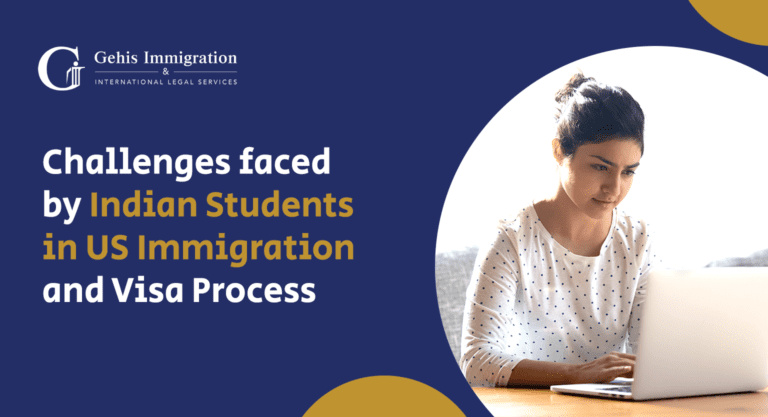Indian students aspire to study in the United States due to the quality of education, research opportunities, and better career prospects. However, the US student visa and immigration process can be complicated, causing stress and financial strain. Financial obstacles, language barriers, a lack of resources, a lengthy application process, and changing immigration regulations create difficulties for Indian students. These challenges can delay their academic and career goals, causing worry and anxiety. It’s crucial to address these issues to ensure Indian students can pursue their educational and professional ambitions in the US.
This essay aims to examine the challenges Indian students face during the immigration and US student visa requirements process and to make suggestions for potential remedies.
It also aims to raise awareness of the challenges that Indian students encounter during the US immigration process and to offer suggestions for potential remedies. Furthermore, it seeks to assist policymakers, educators, and other stakeholders in enhancing the US student visa procedure for Indian students with comparable difficulties by addressing these difficulties.
Why Indian students started to move to the US
Earlier students from India first came to the US in the 1900s to pursue higher education, beginning the history of Indian students in the US. Despite the US’s reputation for higher education and research quality, Indian students migrated to the country in greater numbers in the 1950s and 1960s.
The number of Indian students studying in the US has increased for several reasons. The Indian economy’s explosive growth, which has increased the demand for highly qualified labor, is one important driver. Many Indian students believe that going to school in the US will lead to higher-paying careers and better living conditions. In addition, the Indian educational system heavily emphasizes STEM education, consistent with the US’s emphasis on similar subjects.
The availability of scholarships and financial aid is another factor influencing the increasing number of Indian students studying in the US. Indian students can now more affordably study in the US because of the large financial assistance packages many US universities provide to international students.
With about 200,000 Indian students registered in US schools every year, Indian students anticipate a sizable presence on college and university campuses in the US. Indian students are widely sought after by US employers due to their reputation for academic excellence. They add to the diversity of the American higher education system and offer fresh viewpoints in the classroom and the lab.
Through their tuition payments, living expenditures, and involvement in the US labor market after graduation, Indian students also significantly contribute to the US economy. They are essential in fostering cross-cultural dialogue and mutual understanding between the US and India.
Challenges For Indian Students In US Student Visa Process
There are several challenges that Indian students face when they initiate the immigration and US student visa requirements process, and some of them are listed here :
Obtaining a visa:
Indian students face significant challenges in obtaining a US student visa to study in the US. The visa application process requires students to navigate complex regulations and provide extensive documentation. Even with all the necessary documentation, the US embassy may deny a visa application, which can devastate students who have invested significant time and money in their education plans.
Lengthy visa process:
The US student visa application process can be lengthy, which can be a significant burden for students who need to plan for their studies in advance. This can cause enrollment delays and impact students’ academic and career goals.
High visa rejection rates:
Indian students face higher visa rejection rates compared to students from other countries. This can be due to various factors, including concerns around immigration fraud, lack of strong ties to India, or failure to demonstrate sufficient financial resources.
The impact of travel bans:
Recent travel bans have further complicated the immigration and US student visa requirements process for Indian students. The bans have caused confusion and uncertainty, making it difficult for students to plan for their studies in the US.
Financial Limitations
Indian students who study in the US frequently suffer financially due to high living and tuition costs. Sadly, few financial assistance and scholarship opportunities are available to overseas students, making it difficult for many Indian students—particularly those from lower-income families—to afford to study in the US.
Issues with bank loans:
Indian students may face difficulties obtaining bank loans to finance their studies in the US. Banks may require significant collateral or have strict requirements around the course type or institution students can study at.
Cultural challenges:
Indian students may experience difficulties adjusting to the cultural differences between India and the US. This includes language barriers, social norms and customs differences, discrimination, and racism.
Adjustment to a new environment:
Studying in a new country can be a significant adjustment for many Indian students. Students may struggle with homesickness, loneliness, and isolation.
Restrictions on work hours:
International students are restricted to working a limited number of hours per week while studying in the US. This can make it challenging for Indian students to support themselves financially while studying.
Visa Regulations and Limited Opportunities
Due to visa restrictions on their work hours, Indian students studying in the US may have trouble finding internships and jobs. Their prospects for networking and professional growth may be constrained as a result. A work visa can also be difficult and time-consuming to obtain after finishing one’s studies in the US, as the US government limits the number of skilled worker visas that can be issued. For Indian students, these obstacles may make it difficult to find work possibilities in the US.
Solutions to Challenges Faced by Indian Students in US Immigration
Improving the visa process:
The US government could streamline the visa process for Indian students by reducing bureaucracy, simplifying documentation requirements, and providing clearer guidance to applicants. This could reduce the time and cost burden on students and increase the chances of visa approval.
Financial assistance:
Institutions could increase financial aid and scholarship opportunities for Indian students to help them cover tuition fees and living expenses. This could make studying in the US more accessible for lower-income students.
Cultural support:
Institutions could provide cultural support for Indian students, including counseling services and awareness-raising programs about cultural differences. This could help students adjust to their new environment and mitigate discrimination and racism.
Employment support:
Institutions could increase opportunities for internships and jobs for Indian students, including partnerships with companies that offer training and employment opportunities. They could also advocate for changes to US student visa regulations allowing Indian students to stay in the US after graduation and work legally.
Addressing restrictions on work hours:
The US government could review the restrictions on work hours for international students and potentially increase the number of hours allowed per week. This could help Indian students support themselves financially while studying and gain valuable professional experience.
Changing visa regulations for employment:
The US government could consider changing the visa regulations for employment to make it easier for Indian students to obtain work visas after graduation. This could help retain talented students in the US workforce and strengthen the US-India relationship.
Improving the immigration and US student visa requirements process for Indian students requires a multi-faceted approach that addresses financial, cultural and employment challenges. By providing support and resources to Indian students, institutions and governments can ensure that they have the opportunity to succeed and contribute to the US economy and society.
Final Words on US Student Visa Process Challenges
The immigration and US students visa requirements process to the US is difficult for Indian students in many ways, including getting a visa, dealing with financial obligations, adjusting to American culture, and finding employment. These difficulties may discourage gifted and driven students from following their aspirations and US dreams. Governments and educational institutions must take action to solve these issues and foster an environment that is more inviting and encouraging for Indian students.
The US can attract and keep top talent from India and improve relations with that country by expediting the US student visa process, expanding chances for financial aid and scholarships, offering help on a cultural level, and enhancing work prospects. To build a more varied and inclusive society, policymakers and educational institutions must acknowledge the significance of these initiatives and take action.
In general, overcoming the difficulties Indian students confront in the immigration and US student visa requirements process is a matter of fairness. It will be advantageous for both nations’ economies and societies. We must take action to ensure that gifted students have the chance to grow and have a good impact both in the US and abroad.






